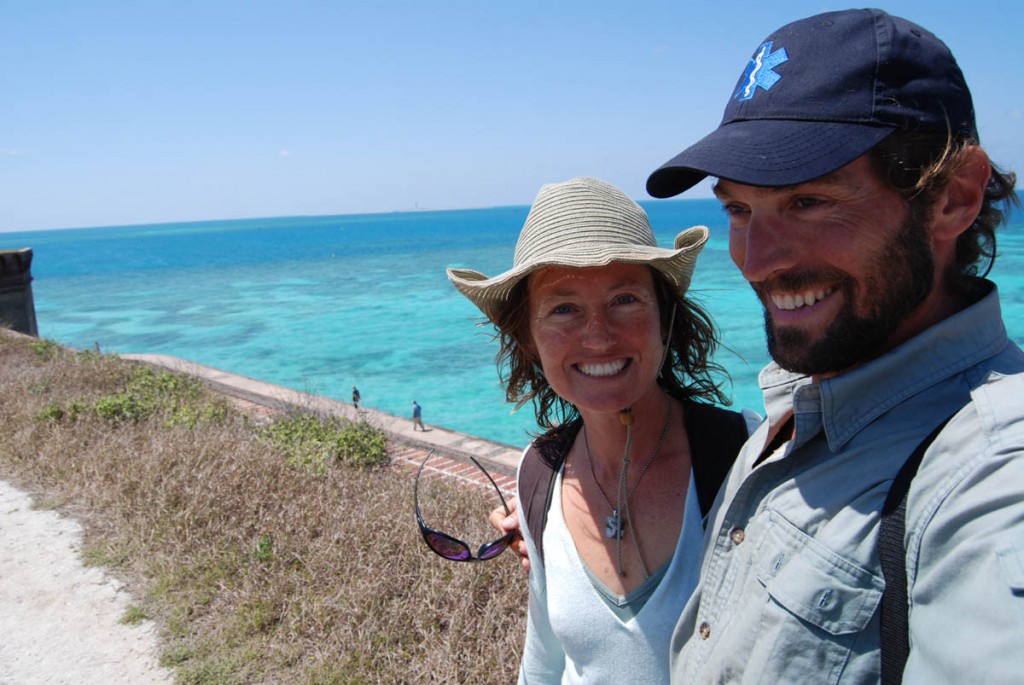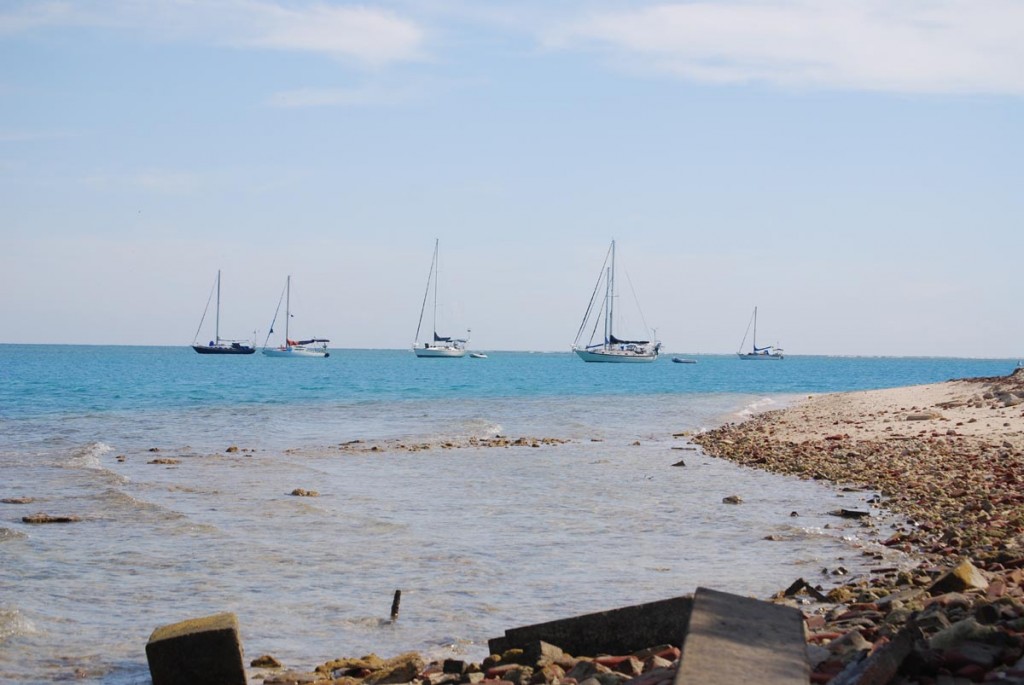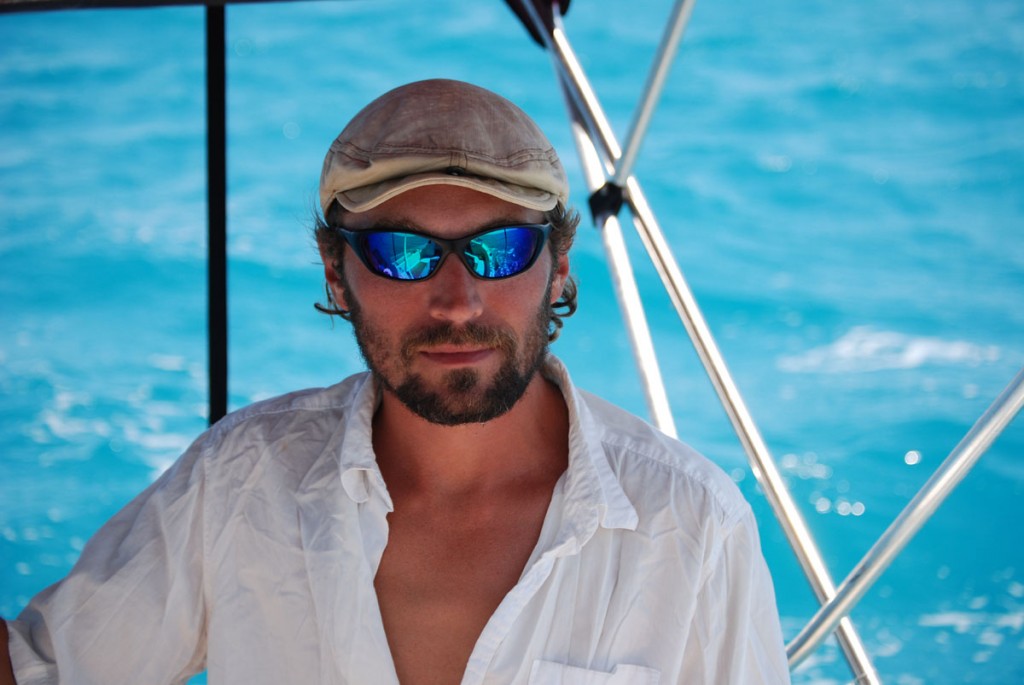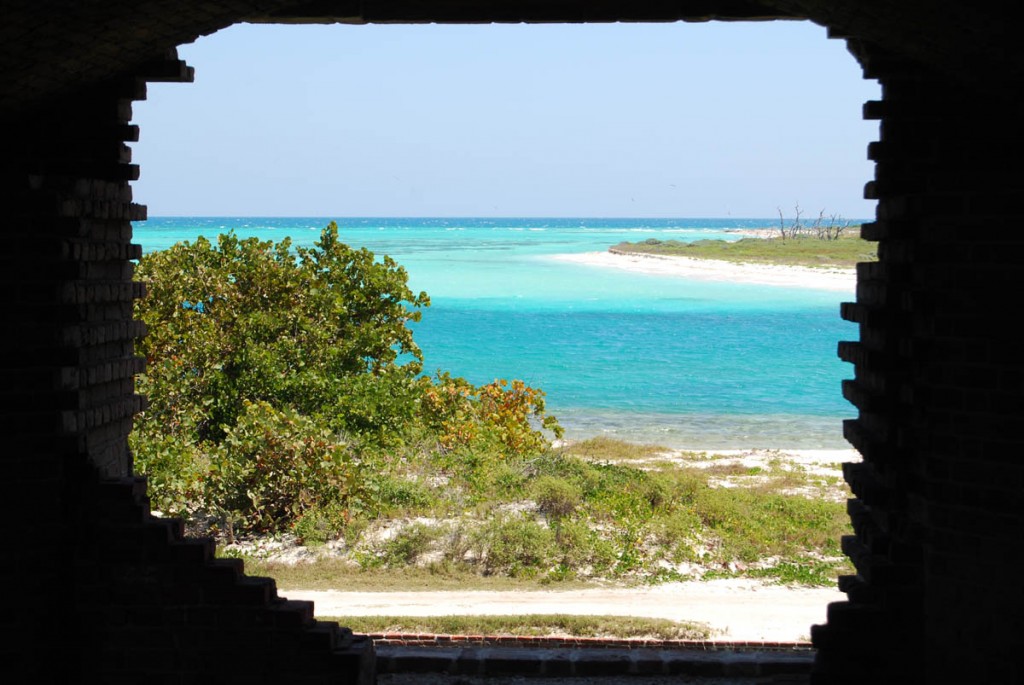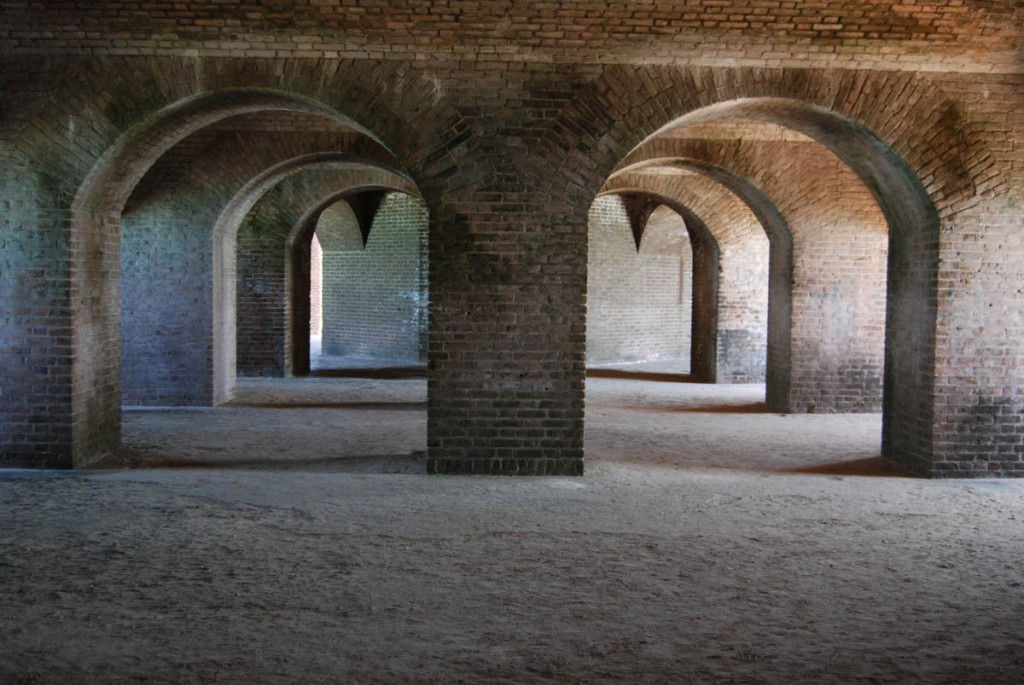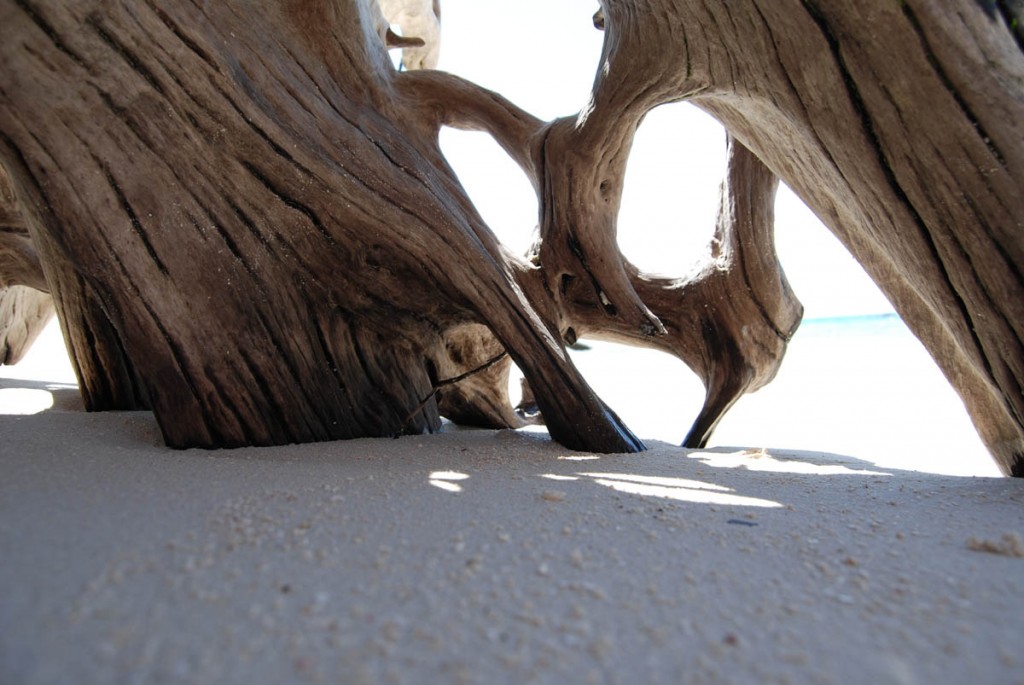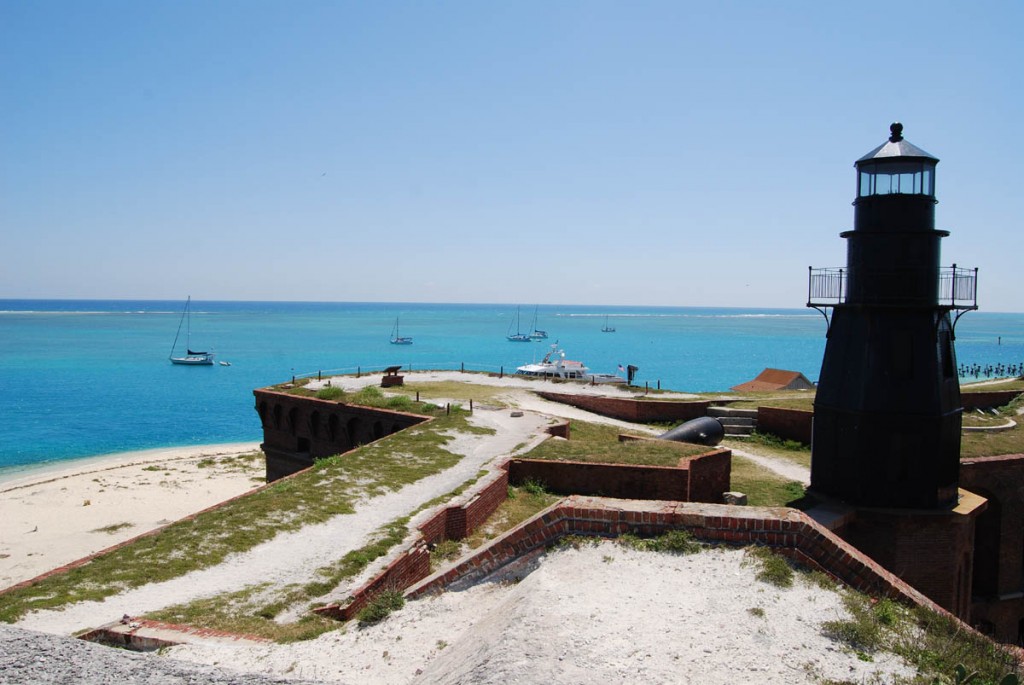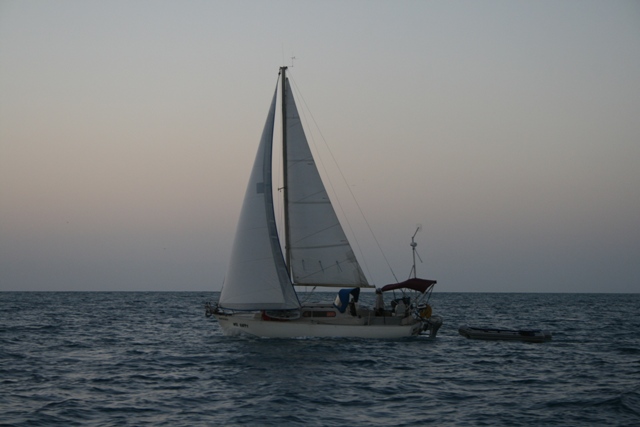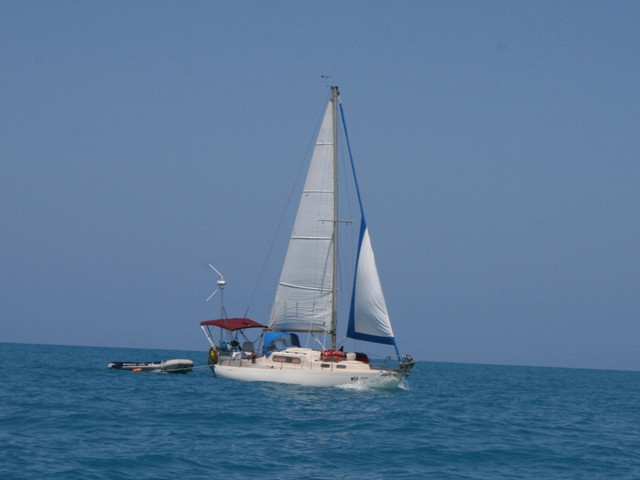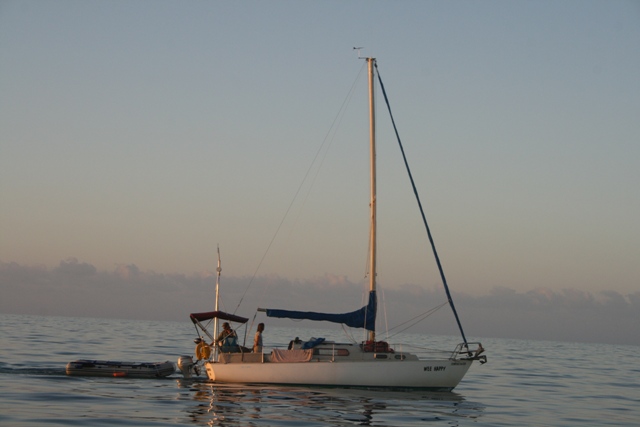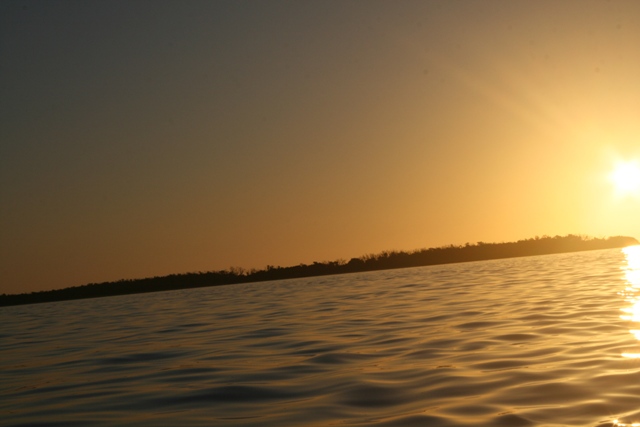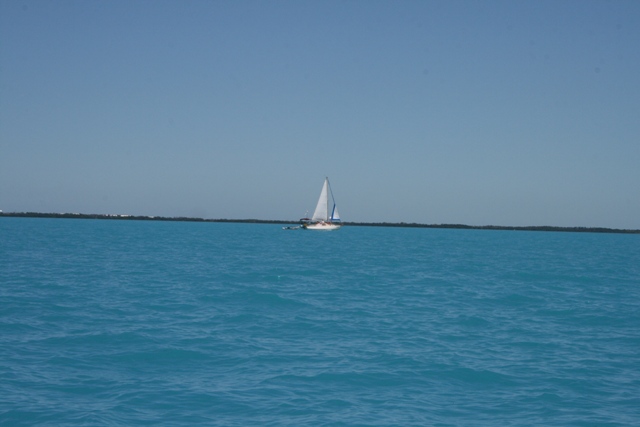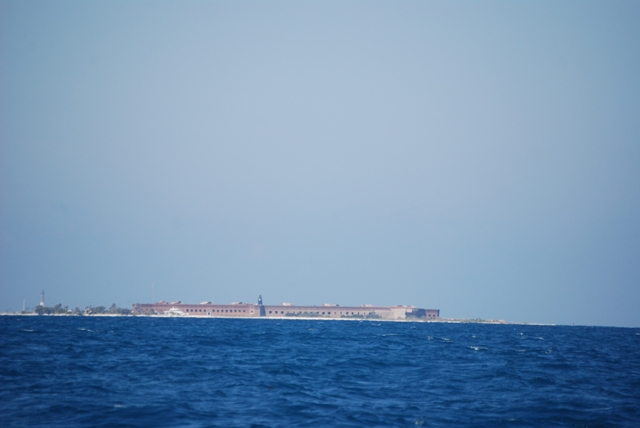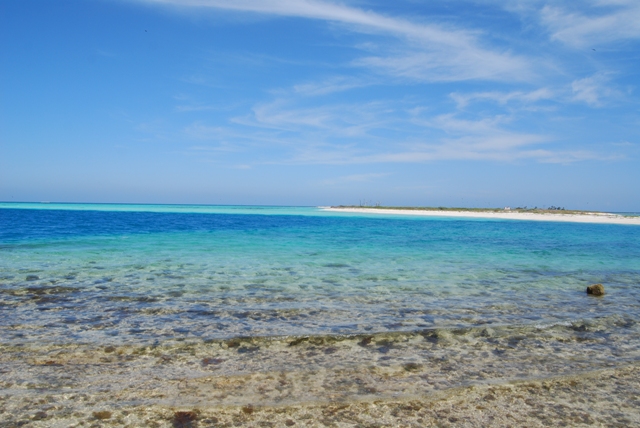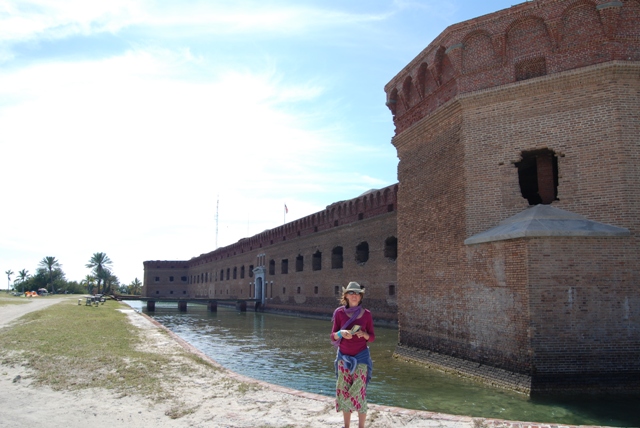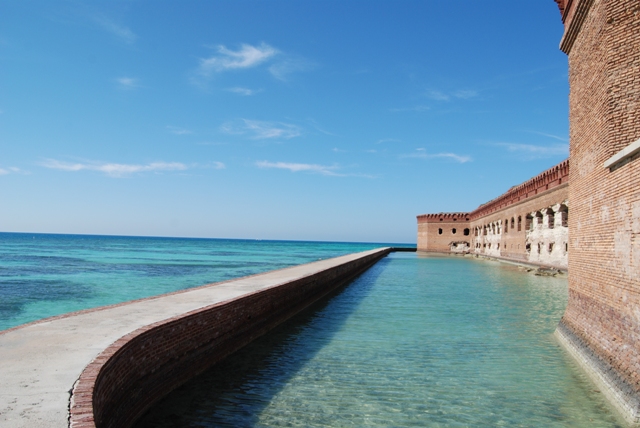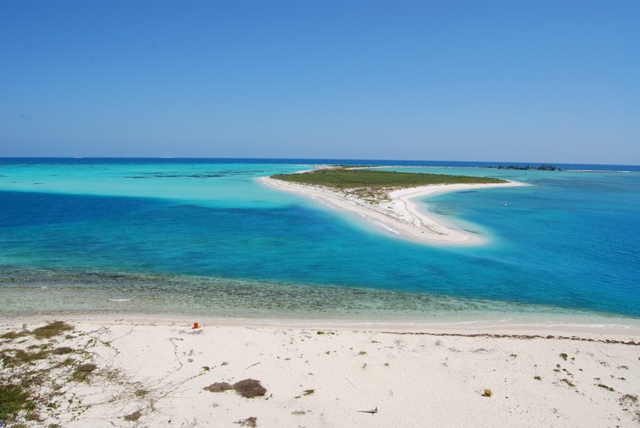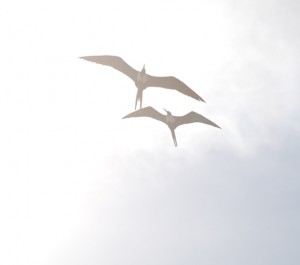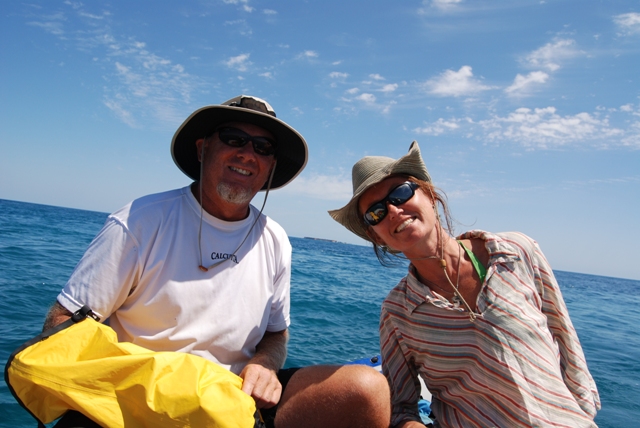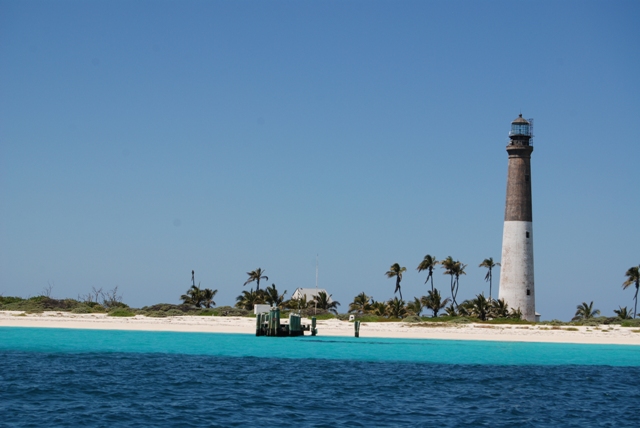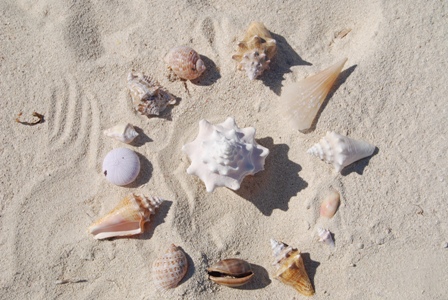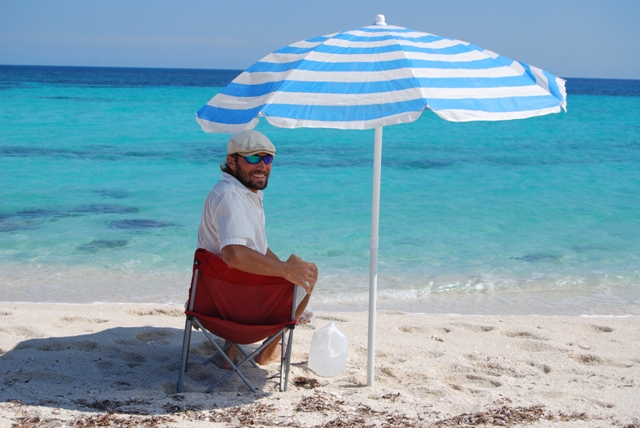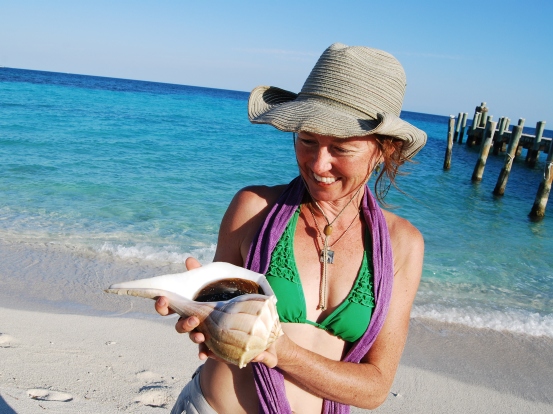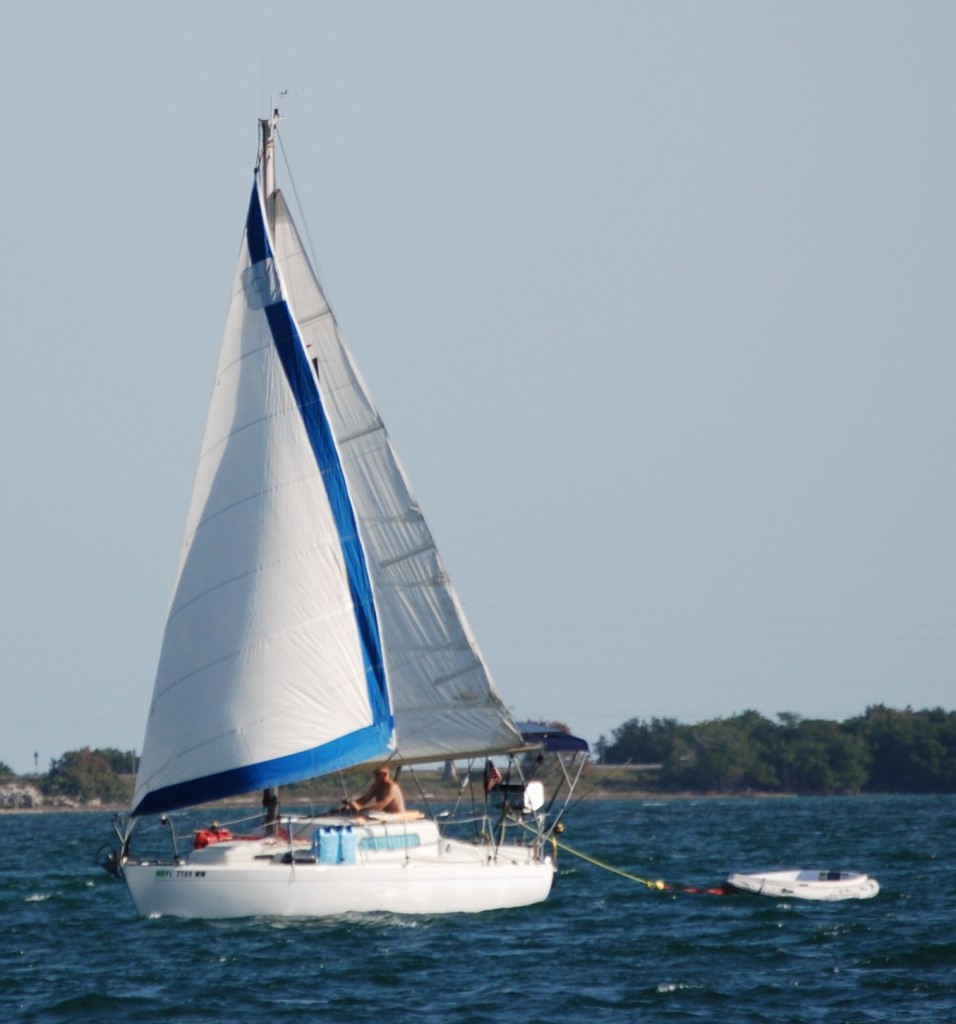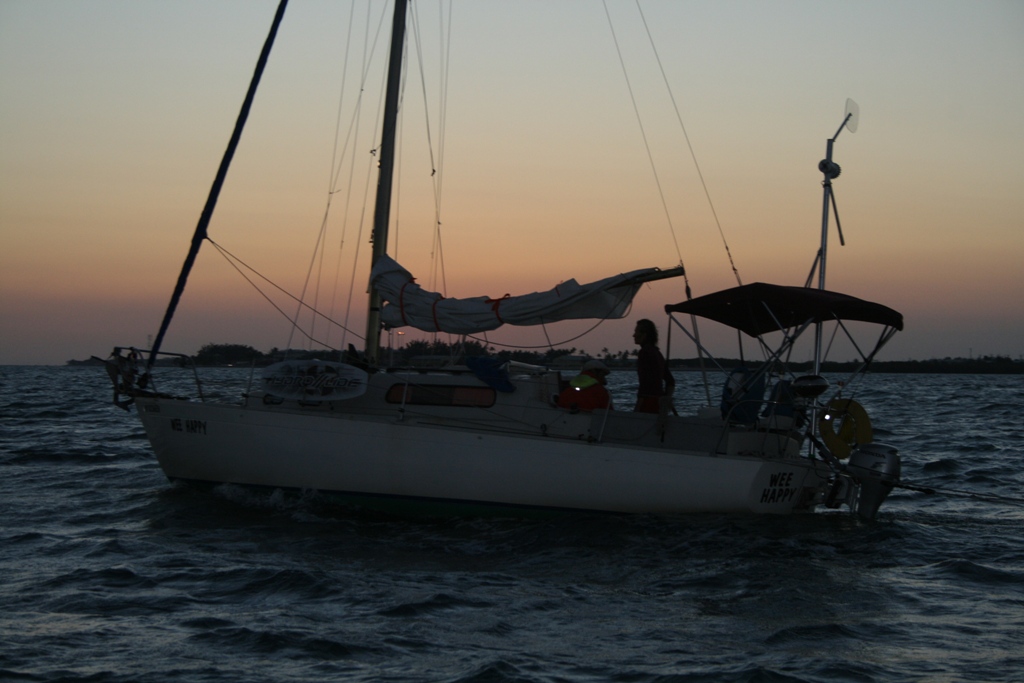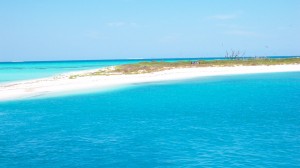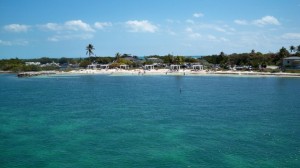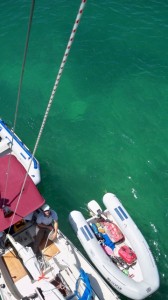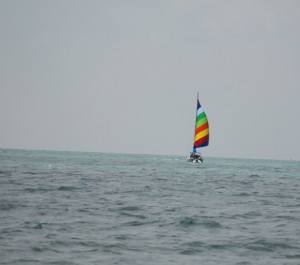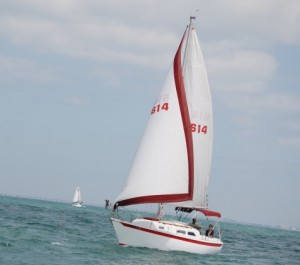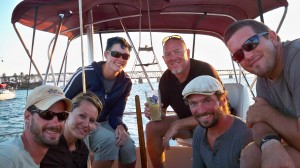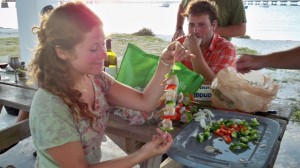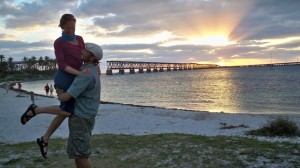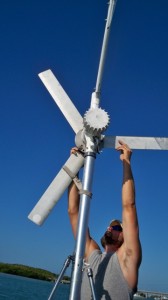A few more images from our journey to the Tortugas….
Monthly Archives: March 2011
Sailing to the Dry Tortugas in an Albin Vega, Part 3
We left the fort at first light before sunrise. Our goal was to make a 45 mile run to the Marquesas keys where we planned to anchor for the night. The wind was forecast to be east/southeast, so we were expecting to be heading into the wind the whole way. That meant planning to have to motor the entire time. Returning the way we came would have meant traveling southeast right into the wind, so we decided to take the northern route back. So once we cleared the outer shelf of the Tortugas, we turned northeast in hopes of being able to sail on a close reach with a southeast wind.
We didn’t have the luck that we wanted, and the wind was more east/northeast than expected. We kept our sails up and sheeted them in as tight as possible. We actually pulled the leeward jib sheet inside the spreaders to get it as close to the centerline as possible, and we still had to run the motor anyway, since we had 45 miles to cover and only 12 hours of daylight to do it in. We didn’t want to get into the Marquesas after dark, as the shoals around them are known as “the quicksands.” They are very shallow and have shifted since the charts were created, so you can’t know what you are going to find until you sound your way in. The prudent sailor goes when the sun is high and behind him so that he can see the bottom. When the sun is low in the sky, all you can see is reflection and glare on the surface of the water, which block seeing the bottom and knowing where the shallow spots are.
The water was as calm as a serene lake. The color was truly astonishing. It just glowed the most alluring vibrant magic blues all day long. It was luminous and enchanting. The winds were present but light, so they kept us cool and maybe added half a knot to our speed. We soaked in the glorious spaciousness of being surrounded by heavenly glowing blue as far as the eye could see in all directions.
We kept the sails up all day but had to keep the motor going all day too. We arrived at the Marquesas keys and slowly approached through the quicksands from the northwest. We crawled in slowly and dropped 2 anchors in a “Bahamian mooring” style in a 1 knot southward current along the west shore of the southwest Marquesas keys, just off of a lovely west beach. We still had two hours of daylight, so the sun was still fairly high. That really helped us to see and dodge the shallow and shifting and uncharted sandbars that we had to navigate on the way in!
Wes, on Gemini Dreams, immediately jumped into his dinghy with fishing rods and cast off for shore. Then he remembered that he hadn’t put his oars in! He was drifting out to sea in a 1 knot current with no supplies! He tried paddling back with his hands, but they didn’t give him enough power to fight the current. So he took off his shoes and used them as hand paddles and made it back to his boat to get his oars! He went ashore and caught dinner.
We packed up supplies and readied ourselves for a camp fire dinner ashore. Finally! We’ve wanted one for a thousand miles, but all of the islands and beaches along the way are inhabited or controlled.
Cooked up rice and beans and green beans and fish on the coals and watched the sunset and ensuing darkening of the sky and unveiling of the stars. They are so bright out there because of the lack of light pollution. Then after dark had completely enveloped us, Wes discovered phosphorescent / bioluminescent life in the shallow tidal flat just off the beach. We were there at low tide, and the tidal flat extended about 200 ft from the beach. Each step that we took on the flats erupted in a pulse of excited spots of light that radiated out in all directions like a shock wave. Imagine turning on stars beneath your feet with every step. Surrounded above by the stars and galaxies of the heavens while releasing hidden galaxies and starfields in the sand beneath our dancing feet was cathartic. Even paddling back out to our boats, each oar stroke would trigger a dozen bioluminescent sparks in the water around our dinghies. The Marquesas are magic, and are highly recommended! Just be sure to bring bug repellant!
The next morning we were off again at first light for another long run. Our goal this time was to make it to Newfound Harbor just west of Bahia Honda. That meant another 45 to 50 miles in just 12 hours of sunlight. So we expected that we’d have to motor all day again, as the winds were forecast to be “light and variable.” We went southward from the Marquesas into Hawk Channel and then headed east towards Key West. We motor sailed along with just the Jib out for about 15 miles until the wind picked up from the north.
The water was luminous Caribbean blue again. The temperature was in the lower 80’s, and we hauled up the main sail to find that we could scream along at up to 6.5 knots under sail! We shut off the motor and relished our unexpected blessing of good winds for ten miles as we passed Key West. With the Autopilot on and the sails trimmed right, Wee Happy just sailed along happy and bouncing and gleeful. It was perfect sailing. It was the dream sailing that everyone has in the keys, but few find because they stay in the middle and upper keys and don’t make it out to Key West and beyond.
Then we crossed a line in the water where the color ceased to glow any longer. It changed from the enticing enchanting blue to everglade green. Think olive green with a little brown in it, and you’ll imagine it right. Oh well. Welcome back to the middle keys. Just about the same time, the wind went “light and variable” again and we had to start the motor to have hope of making our anchorage before sunfall.
We slowly approached Newfound Harbor just before 6:00pm, and had to fight against a 2 knot tidal current and large fast motorboat wakes to make it into the harbor. It took almost an hour to travel the additional 4 miles to get to the spot where we dropped anchor, and once we were there we realized it would be a 2 mile dinghy ride to any restaurants or grocery stores. By this time we were completely out of ice and most all food that required coolness to stay edible, so not being able to go ashore to get dinner was frustrating.
So Wes came over and we made our last dinner together before we plan to part ways. We swapped photographs and relived stories. He’s going home to northern panhandle Florida from Marathon, and we are planning to continue up the keys to cross to the Bahamas. The anchorage, although remote, was pristinely calm. It was almost like sleeping on land. It was quiet and spacious.
That’s the end of the Dry Tortugas story, but we have lots more pictures that we will post shortly, so stay tuned!
Sailing to Dry Tortugas in an Albin Vega, Part 2
By morning we headed the last 20 miles to the Dry Tortugas on a perfect broad reach (this point of sail is easy and beautiful). The morning light greeted us warmly, and we awakened to the color of exquisite blue waters all around us. A sea turtle, feasting on a school of small jellyfish, raised his head out of the water to say good morning. Being out there with nothing else to see in all directions but the glorious blue waters and clear sky was truly a spiritual experience. It felt cleansing to the soul, purifying to the mind. Nothing else to do out there but just be with the majesty of the sea. Lala finally really understood the sailor’s call to the sea.
And then, Land Ho! Fort Jefferson appears on the distant horizon! We’re almost there!! Or so it seemed. For hours we watched the fort and the island SLOWLY get bigger and bigger, until we finally made it to the entrance of the channel leading in to the anchorage. Even then it took us another hour to round the fort and pull in to the anchorage. We arrived around noon, exactly what we had predicted. We sailed the entire way, except for a very short stretch where the waters got confused and the sailing was so annoying we turned the motor on for a few minutes to power through. We feel a sense of happy accomplishment at reaching our goal, a tiny series of islands out in the “grand bleu”. Having another boat sailing with us, and another Vega at that, was very helpful. Thanks to Wes on Gemini Dreams for being such a great sailing buddy! By the way, there is a link to his blog in the links section on in the right hand column at the top.
The colors of the water here are unbelievable. The most delicious shades of aqua, turquoise, and deep clear blue surround us. We can’t stop being astonished at how beautiful the colors are. In the rest of the Keys the water are more often green, but here they are dreamy shades of turquoise. Color therapy!
The most prominent feature of the Dry Tortugas is Fort Jefferson, a brick fort built in the 1800’s to guard the Gulf of Mexico. Now it is a National Park and historic site. The little boy in Cap’t K. came out as we neared the fort — it had a moat, cannons, and a big lighthouse. How exciting to sail out to an island with a big fort on it! The fort has an excellent weather radio with a huge antenna that can get seven different weather stations in. They also post the local NOAA forecast in the visitor’s office daily. The best thing about the fort is the snorkeling, so definitely have mask, fins, and snorkel and an underwater camera. The fishing out here is excellent too so get your license and bring gear.
The local authorities commonly board and inspect the boats in the harbor. They are reputed to be very courteous, but have your boat in order and expect to be boarded & inspected. Cost to use the park is $5 per person and must be paid upon arrival. This can be done 24 hours a day by filling out an envelope form and dropping it with payment into a locked mailbox. The pass is good for seven days.
You can also camp in one of the few campsites right next to the fort. These are very nice, and there is sun shade on most of them, along with a barbecue grill and post for hanging a solar shower/backpack/etc. There are composting toilets for the campers to use after the ferry leaves, but everyone is expected to use the ferry’s toilets while the ferry is here. Unfortunately the fort runs a huge diesel electric generator 24hours per day, and it is close to the camp sites, so if you camp then you are listening to it for your entire stay.
Right next to Fort Jefferson is Bush Key, an island with no buildings on it that is closed to the public during the migration season. The entire island is covered in birds. Not that many bushes on the island, it should be called Bird Key. It is a major nesting area for many types of terns as well as hundreds of other birds. The birds flew around in a large circle over the island, thousands of them, day and night. It was like a giant rave party for the birds. The sound of the bird calls never stopped, even in the middle of the night. It was an amazing sight (and sounds). The anchorage was right next to the island, so we got to have a front seat watching the birds. We were also amazed to discover Magnificent Frigate birds soaring above the fort and the island. Magnificent is truly the best word to describe these large birds, who glide effortlessly and gracefully for hours on end without flapping their wings. One day we went to the far end of Bird Key in our dinghy and discovered a separate nesting area there that was the unique domain of the magnificent frigate birds.
While mating, some of the birds (probably the males) get large red balloon like sacs protruding from their necks. It is a really unusual sight to see these giant black birds with big red balloons hanging from them.We went ashore to the Fort and used the facilities aboard the fastcat (ferry boat from Key West). Everyone on the island is supposed to use the bathroom on the ferry when it is at the island. The campers use composting toilets after the fatcat leaves. While aboard, we got lunch in the cafeteria line. Great deli sandwiches in a make-it-yourself line with a free soda and glass of water and couple of cookies. There really is a free lunch somewhere in the world!
After we finished our lunch, we piled in the dinghy with Wes for an expedition over to Loggerhead Key. This is the westernmost of the Florida keys. The ferry does not go there, and since it is three miles away from the fort, most cruisers don’t go there either. It’s not accessible by kayak due to the wind and currents, unless you are crazy and don’t mind getting blown across the Gulf to Mexico. It was another island out of a romantic dream. 3 miles from Fort Jefferson, this island is ringed entirely by a white sand beach, and has a glorious 19th century lighthouse, and a little house for the lighthouse keeper in the middle of it.
Since we have the uber dinghy though, we set out on our exhibition across three miles of open blue water. Of course, I’d read horror stories about people in these keys who weren’t prepared for engine problems while dinghying around. One couple had set out in excitement for one of the little keys around the fort only to find their engine stopped a mile out. The current was setting them out to the gulf, and they were completely unprepared.
They didn’t have an anchor. They didn’t have oars. They didn’t have drinking water, and they didn’t have a radio! Luckily they got their motor to work before they hit the gulf stream! Anyway, I learned from them, and we were prepared with 200 feet of anchor line and an anchor, a handheld radio, flares, water, oars, life jackets, etc…
The weather was great, and we didn’t need any of the safety gear, but I was glad we have such a large and capable dinghy. It’s really a runabout, not a dinghy. We made it to Loggerhead without a problem. It was a lot father away than it looked.
We touched down on pristine coral sand beach and immediately started jumping up and down with joy. IT was so much nicer than For Jefferson’s Key. We remarked how many people go to the fort and never make it just three more miles to the very last key, which also happens to be the most beautiful of all. Tall coconut palms surrounded the 115’ solar electric lighthouse. The island even has a resident ranger in a sweet little house. Wouldn’t I like his job!
Walking around to explore this idyllic island, we were struck speechless by the amazing colors of the water. The west side of the island is sheltered from the predominantly east wind, and it is surrounded by an immense and complex reef. We circumnavigated the island. Coming back up the southeast side we found more shells and coral and sponges than we had ever seen before. The predominant east wind and waves bring all these sea treasures ashore in this one spot. Like kids on the beach we collected and compared our treasures.
Back at our landing spot at the dinghy we regrouped. Lala and Wes suited up for skin diving, and Capt’n K set out our sunbrella and a camp chair. Down he sat with a new book as they went snorkeling just a few feet from the beach and saw lots of brightly colored fish, gorgeous coral heads, and dancing sea fans. They also snorkeled near the long pier that juts out from one side of the island, and there Lala saw more fish than she’d ever seen. Thousands of fish were grouped under the pilings, including the BIGGEST FISH she’d ever seen. It was so big that when she first saw it she was afraid — it was almost as big as her. It was a least 4 feet long and must have weighed over a hundred pounds. They followed it around for a while, and Wes told Lala that it was a “Jewfish”, also known as a Goliath Grouper. When Lala got back to shore she ran up to K., who was in his “happy place” under a beach umbrella reading a book, and excitedly told him “I saw a fish THIS big”, and of course he couldn’t believe it until he saw it himself from the pier!
If the little boy in K. came out when we arrived at the big fort, the little girl in Lala came out while looking on the beach for seashells. The beach was covered in amazing shells, including big huge conch shells. We found dozens of them! Some of them were even still alive. At the end of the day, on Lala’s last stroll down the beach, she found right at the water line, a giant spiral shell just washed up by the sea only minutes before. This gracefully curved spiral had a creature living in it, so we ended up giving it back to the ocean. It was the biggest, most beautiful shell she’d ever found and she’s still squealing in delight over it!
Then we packed up and headed back to the anchorage near the fort. K was nervous about the run back because we got some sand into the prop when we had beached the dinghy. It was windward the whole way, and we were taking on spray, but the 15 horse pushed us right along into the chop without a problem. He’s really glad that we have such a capable dinghy! There’s no way we’d have been able to make this expedition without such a large and powerful dinghy and outboard. No wonder Loggerhead is so untouched! What a gift it was to enjoy and experience this amazing place.
More to come in our next posts, so stay tuned and check back! Make sure to leave a comment to say Hi and tell us that you stopped by for a read!
Sailing to the Dry Tortugas, Part 1
We have been planning on going to the Dry Tortugas for over a month. Things kept getting in the way, like work projects, the weather, etc. We were starting to think that maybe we didn’t have time after all to get all the way out there and back before a fire performance gig we had booked for March 26.
Looking at the forecast showed seven days of good weather and nice winds. Sailing for the day from Isla Morada to Key West, where we planned to stay the night and provision for the trip to the Tortugas, we enjoyed the conditions so much that we remarked that “if the whole trip to the Tortugas would be like this, we’d just ail through the night.”
Let’s just GET there already! The Dry Tortugas is about 70 miles from Key West, so it would take us approximately 20 hours to get there. We wanted to arrive in the daylight, so that meant going through the night. We had our buddy boat Gemini Dreams with us, and he too wanted to make the trip but didn’t want to do it alone. It would be the first time for both of us sailing out on the open ocean out of sight of land. A big milestone!
We stopped at a marina on the east side of Key West on Stock Island, Oceanside marina. We filled up with gas and ice. Lala, and Wes from Gemini Dreams, went to the bus and then on to the grocery store and K mart. Capt’n K stayed aboard and researched the weather and talked to tow boatUS about our planned route and any local knowledge they could impart.
The weather forecast was for 7 day of mostly sunny conditions with NE to SE winds between 10 and 20 knots. For the trip out there, the forecast was for E-NE winds around 15 knots, with clear skies and an almost full moon. How perfect! We called friends and family and told them about our plan. We told them our itinerary and route and asked them to wait to hear for us until a certain date and time, and if we hadn’t checked in by then they should call the coast guard and have them send out a search and rescue boat. we always do that when we go out on trips into the wilderness or water. If no one knows where you are going, what route you are going, and when you are supposed to be back, then you have next to no hope of being found.
We have an 8-horse Honda bf8d 4-stroke outboard. It’s supposed to average about 0.5 to 0.8 gallons per hour, but at full throttle into the wind and seas, I bet it could use a gallon per hour. So if we had to motor for 24 hours at 3 knots to make it back to Key West, we’d need 24 gallons. Lala picked up an extra gas can so that we could carry at least 25 gallons on board for the trip. We currently only had two 5-gallon cans and a 7-gallon portable tank, totaling 17 gallons. If we were to have to motor back at full throttle into the wind and heavy seas, we would need more than that.
So Lala got food and an extra gas can and gas, and so did Wes. Capt’n K checked over the boat and inspected all the rigging. He remembered that he still hadn’t put the cotter pins back in the turnbuckles on the stays and shrouds (the cables that hold the mast up), so he got them in before we left. He took the outboard off the dinghy and stowed it on desk so that the dinghy would be easier to tow. We have a 10.6 foot long dinghy, so it’s too big to put on deck. The lesser of the two evils is to lighten the dinghy by emptying its contents and then just tow it.
So even though we were quite nervous, we set out from Key West at sunset. A glorious sunset it was, too. With East winds blowing a steady 10-15 knots, we had a downwind run almost the whole way. Sometimes downwind sailing can be a breeze, and sometimes it can be REALLY annoying. We experienced a bit of both. For Lala, sailing downwind is the most challenging point of sail, and when the boat gets rolly and the sails won’t stay full, it makes her CRAZY with aggravation. But when the sailing is easy, well….she loves that part! The seas were pretty gentle and they rolled us along at a steady 4 knots through the night. We didn’t fly our cruising spinnaker because Wes doesn’t have one, and we wanted to stay close to each other all night. It was a good thing too, because he was sailing solo, and got very tired after over 20 hours holding the tiller. A little chit-chat on the radio and keeping tabs on each other kept us awake and safe.
Capt’n K remembered a lesson that Rene in New Jersey had taught us about towing a dinghy. He put it out behind us and fiddled with the length of tow rope until he got the dinghy riding the crest of waves two waves behind us at the time we were cresting the wave we were on. This stopped the dinghy from being tossed up close on our stern and then falling back away from our boat and being violently pulled forward again by the tow line. If you tow your dinghy in following seas, play with the length of the rope until you get it in the same part of the wave that you are on. Then you can basically forget about it because it’s so easy to tow! What a joy to not have the stress of a lurching and worrisome dinghy!
We passed one sailboat in the night who didn’t have all his lights working and didn’t answer the radio on ch 16 or 68…bad bad bad! Hope he was okay! We learned about Sand Key Light’s different colors for different directions. If you are in Hawk channel the light is white, but if you are too far south and in the shoal danger zone, then the light is red. Cool! We never spotted the 2nd lighthouse of the route however. Being out this far, any lights you can see are a valuable asset, and they are very few and far between. Imagine driving in the dark without street lights or headlights.
We were able to take two to three hour shifts on watch while the other rested in the cabin. We had a working autopilot which meant we didn’t have to hold the tiller the whole time. Wes on Gemini Dreams, however, had to do the whole trip solo and without an autopilot! He sure was exhausted by twilight! We kept chit chatting on the radio to help stay awake and alert. The currents around Rebecca shoal set us to the north, and we had a difficult time staying far enough south to clear the “Tide Rip” on the chart. We’d gotten a bit separated from Wes, so we hove to and let him catch up a bit. Once we got back together it was such an emotional relief. Being all alone out there in the black on your first time out is scary! Luckily we didn’t snag a crab pot because we could see them in the moonlight.
Sailed most of the way but decided to lower sails and motor when we were clearing Rebecca shoal. There were confused waters there because the currents from north and south of the shoals converge there. We didn’t get sick, but we could have. Glad we hadn’t consumed any alcohol the day before we left! After we got clear of the convergence we were able to go back to sail and made a reach for 20 miles to the DTs. We tracked our progress by noting gps coordinates and speed and wind & wave direction periodically on paper charts and a notepad in case we lost our gps for some reason.
This is just the beginning. Most of the story and all of the beautiful photos and video are yet to come. Stay tuned!
Back from the Tortugas
We Made it! We’re back! More to come! We just got back to Key West, and we’re on our way to Marathon via Newfound Harbor. When we get time soon we’ll post all about our trip. In the mean time, enjoy this fabulous picture of Bush Key in the Dry Tortugas! Click on it to view it full size!
Sailing to Key West
On our way to Key West from Bahia Honda. ENE winds 10-15knots. Sailing by the lee with our main to windward with a preventer to the bow cleat and our gennaker to leeward. What a sweet sailing day here!
3 strikes for the Wee Armada
We got out of the harbor to discover big ocean swells coming out of the southeast, and since we had to go slightly downwind, we got uncomfortably rocked in the swells. The wind wasn’t that strong, but the swells were really large. That combination is tricky– we couldn’t keep the sails full when the boat was rocked so strongly and sails would occasionally snap violently with the rocking of the boat. Cap’t K. was commenting on how bad that is for the rigging, and we were exploring other points of sail to make it more comfortable, when we looked up and saw our genoa coming down! The snap shackle that connects the sail to the top of the mast had come loose and dropped our sail! We caught it before it went in the water and stuffed it in the V-berth and managed to successfully heave to while we pondered our options. We were only a few miles out from Bahia Honda, and so we decided to turn around and go back to fix our sail.
Meanwhile, Sara and Trevor were also getting rocked like a bucking horse and were having major engine problems. They too turned around and came back.
Wes was doing fine, but decided to come back with us since we were forming a traveling team, and so he also turned around. But as he was tacking back towards the harbor, the violent rocking of the boat and the snapping of the sails tore his genoa sail in multiple places and he too, limped back into the harbor!!
Right after we anchored we noticed another boat stumbling back in from the giant swells also with a torn genoa sail! A dangerous day to be out considering it seemed like such a nice day!
So we are all “stuck” here in paradise for another day.
Luckily, we only had a small part to replace and suffered no major damage. Wes was not so lucky as he has to have major sail repair done now. Earendil had a spare part we were able to use to reattach our sail to the boat. But doing so meant someone had to climb to the top of the mast to retrieve the broken snap shackle. Cap’t K. was not feeling his normal superhuman self today because he pulled a muscle in his shoulder and has been in pain all day with minimal range of movement. So guess whose turn it was to climb the mast?! Yes, I faced a great fear today and did my sailor’s duty of climbing to the top of the mast! I’m not fond of heights, and I was pretty scared going up. Our friend Kurt has a bosun chair (a.k.a. climbing harness) that we used to hoist me up with the mainsail line. With Kurt and Cap’t K. pulling the lines, I was lifted high, high, up above the water. About halfway up I started freaking out and panicking, but then I realized that I actually was pretty stable in the harness and that it was beautifully awesome up there, and I ended up doing better than I thought I would. I even managed to snap a few photos from the air:
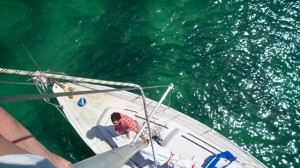
All’s well that ends well. We’ll try again tomorrow!
the Wee Armada
We did it! We got out of the vortex of Boot Key Harbor! AND, we gathered a wee armada of 27 foot sailboats to go with us. 4 sailboats total, all 27 footers….We all had a few things in common: we are on 27 foot sailboats and we are not retired. We made our way downwind together to the famed Bahia Honda Beach. An epically beautiful day.
There is a phenomenon that tends to happen in Boot Key Harbor that causes people to stay in the harbor for longer than anticipated and they stop going out sailing. We noticed the pull ourselves, and we have also been surprised to see it in others even more than us. People come long distances in their boats to spend time in one of the best sailing grounds in North America, only to just sit in the harbor and stop sailing. We discovered that it was not uncommon for people to be there for months and not go out at all in their boats. We have also discovered that the bigger the boat, the more reasons there are to not go out sailing. There are more things to break and need repaired, there is more expense to buy and maintain the boat, therefore more time that needs to be spent working and not sailing. And, when you live aboard, it’s easier to fill a large deck up with stuff that needs to be moved in order to go out sailing and just getting the boat ready to go out becomes a major task. So there is a plug for the benefit of a simpler, wee boat!
So we managed to break the inertia and convinced our friends aboard 27 footers to sail with us the whopping 10 miles to Bahia Honda. Whoo Hoo!
Sara and Trevor led the pack in Earendil, a 27 foot Hunter, leading the way with their glorious rainbow colored genoa sail. Our friend Wes, in his Albin Vega just like ours (only a bit more spiffy with a new coat of hull paint) joined the pack. And our friends Dave and Janae went on their first solo sail ever in their new boat, Wave Dancer, a 27 foot Erickson. We became the Wee Armada!The Wee Armada needed to eat once we got all anchored safely in harbor. How many people can you fit onto a 27 foot boat? 7 is the maximum number any of us had hosted on any of our 27 foot boats, and we boat hopped for dinner. First it was drinks, chips, and salsa aboard Wee Happy.
Then, we discovered a new version of a potluck aboard Earendil. Everyone went back to their respective boats to make their contribution to our one-dish potluck meal: Wave Dancer cooked pasta, Gemini Dreams made sauce, Wee Happy sauteed peppers and mushrooms, and Earendil cooked sausages. Everyone brought their food over to Earendil’s boat (because they had the big table on their boat!), and we ended up with one delicious pasta dish!!
Conversation about issues particular to wee boats went on late into the evening, when we finally decided to play cards. We played a game of “Bullshit” and Cap’t. K and I failed miserably in the skill of lying.
Then, everyone aboard the wee boats in the Wee Armada went to sleep, hoping to not drag their anchors between the two tall bridges. We all dreamed some version of waking up dangerously close to a bridge…..
Today we hung out on various parts of the long Bahia Honda Beach. We even went out to a small island with our friends cat and our kite. The cat freaked out. The kite flew high. Our friends Kurt and Christina arrived, (on a 35 footer. but still honorary members of the Wee Armada), Dave and Janae left, and all who were present had grilled shrimp kabobs on the beach at sunset. The Wee Armada Rules!
Anchorage Adventures
As some of you know, most of the time we’ve been in Boot Key Harbor we were on a safe, easy mooring ball. A few weeks ago we moved to the anchorage, where it’s free. But it’s not as secure as being on one of those mooring balls! There is a price to pay either way.
There was a big storm forecasted to blow through here tonight. Everyone was saying (including the official weather reports) that it would be here in the late afternoon or evening. K and I were planning on getting our anchor reset by the end of the afternoon to prepare for the shift of strong winds coming our way. Around noon we noticed big, ominous clouds coming in from the west. They quickly got darker and darker, and we decided to reset the anchor before it hit. Wow, did we act with divine timing!! The storm front hit unbelievably fast, with a solid wall of 30-50 knot winds. It literally went from completely calm to 40 knot winds in about 2 minutes! Not even 1 minute after we got the anchor down, we were hanging on for dear life as the wind gusted with a force we have never seen before. We watched anxiously as boats all around us (who had not reset their anchors) started dragging around the anchorage. Some had hair raising narrow misses with other boats, a few ran aground on the sandbar to our south. Here is a little video of the storm:
The major storm has blown through now, and everyone in the anchorage is starting to get out and help the stranded neighbors who ran aground.
We were originally planning on leaving today, but problems that came up with our wind generator have kept us here a few more days…guess it’s a good thing we stayed put! I hate to even imagine how stressful it would have been to be out and about sailing in this storm!! Now our hopeful departure date is sometime this weekend.
Early Morning Visitor
This morning we woke up extra early, thanks to our cat SlowMo who puked up a hairball 5 inches from my head. Although it was a REALLY gross way to wake up, it’s been lovely having these early morning hours to get extra stuff done. And we got to see a very special visitor who came to our boat to say hello.
We are calling this lovely creature a spotted ray, although it may have another more official name. What a peaceful, serene creature! It moved gracefully through the water like it was flying. It flew over to our boat, circled slowly a few times, and went off into the turquoise blue water. We’ve never seen one up close before, although I have seen other types of rays that I heard were called Eagle Rays, jump VERY high out of the water, and they make an impressively huge splash.
This morning Cap’t K. tackled the last stage of installing the wind generator. He had to contort himself into crazy and dangerous positions to install this heavy piece of equipment up on a pole that is mounted on the stern of Wee Happy. Here he is putting the last propeller blade up:
The wind generator is now spinning in the wind beautifully and K. is doing the final install of attaching the cables to the batteries as I write. This will be a major improvement in our power situation, as we only had a very wee 20 watt solar panel before. We were extremely blessed in getting this used wind generator for a mere $35 plus the cost of a few nuts and bolts and the cables….normally these things cost THOUSANDS of dollars, so we got the deal of a lifetime!
